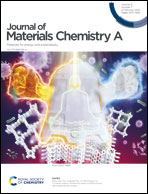Activating the lattice oxygen oxidation mechanism in amorphous molybdenum cobalt oxide nanosheets for water oxidation†
Abstract
The cost-effective deployment of several key energy technologies, such as water electrolysis, CO2 electroreduction and metal–air batteries, relies on the design and engineering of cost-effective catalysts able to accelerate the sluggish kinetics of the oxygen evolution reaction (OER). Herein, we detail the synthesis, processing and performance of a cobalt oxide-based OER electrocatalyst with optimized composition, atomic arrangement and nano/microstructure. We demonstrate that doping the cobalt oxide with a higher electronegativity element such as molybdenum promotes the participation of lattice oxygen in the OER. Besides, the processing of the catalyst at moderate temperatures results in an amorphous material with extended compositional and atomic arrangement versatility. Additionally, the catalyst, which is produced through an ion etching assisted strategy using ZIF-67 as a template, displays a highly porous structure in the form of amorphous ultrathin MoCoxOy nanosheets that maximize interaction with the media and facilitate the transport of ions through the electrolyte. After optimizing the molybdenum concentration and structural parameters, the best MoCoxOy catalysts exhibited a low overpotential of 282 mV at 10 mA cm−2 with a reduced Tafel slope of 60.6 mV dec−1, and excellent stability with more than 60 h operation without significant activity decay.



 Please wait while we load your content...
Please wait while we load your content...